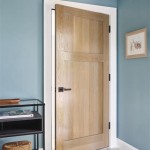What Color To Paint Interior Doors With Wood Trim
One of the most impactful yet often overlooked design choices in a home is the color of interior doors, especially when balanced against existing wood trim. The integration of door color with wood trim can significantly affect the perception of space, light, and overall aesthetic harmony. Selecting the right color involves considering the tone and style of the wood trim, the existing wall colors, and the desired mood of the room. This article provides a comprehensive guide to navigating the complexities of this decision, offering insights into color families, design principles, and practical application tips.
The decision-making process begins with an assessment of the wood trim itself. Different wood species exhibit varying hues and undertones. Oak trim, for instance, often displays warm yellow or orange undertones, while cherry wood presents richer red tones. The finish applied to the wood further modifies its color. A glossy polyurethane finish will accentuate the natural color and grain, while a stain can drastically alter the wood's appearance, ranging from light and airy to dark and dramatic. Understanding these nuances is crucial for selecting a complementary door color that enhances, rather than clashes with, the existing woodwork.
The goal is generally to achieve a cohesive look. This does not necessarily mean the door and trim should be the same color. In fact, contrast can often create a more visually interesting and dynamic space. However, the key lies in ensuring that the colors harmonize, sharing similar undertones or intensities. Before committing to a specific color, it is highly recommended to obtain paint samples and test them against the wood trim in various lighting conditions. This allows for a more accurate assessment of how the colors will interact and ensures that the final result aligns with the desired aesthetic.
Understanding Undertones and Color Harmony
A fundamental principle in color selection is understanding undertones. Every color, including whites and neutrals, possesses an underlying hue that influences how it interacts with other colors. Identifying the undertones in the wood trim is the first step in finding complementary door colors. For example, if the wood trim has warm yellow undertones, colors with similar warm undertones, such as creams, yellows, oranges, or even warm grays, will generally create a harmonious effect. Conversely, colors with cool undertones, such as blues, greens, or purples, might clash with the warmth of the wood, unless a deliberate contrast is desired.
Cool-toned wood trim, which is less common but present in some modern designs or when wood is treated with certain stains, pairs well with cooler colors for the doors. Soft blues, greens, grays, and even muted purples can create a soothing and sophisticated atmosphere. The contrast between the cool wood and the slightly warmer tones in these hues can add depth and visual interest. When working with cool-toned wood, avoid overly warm colors like bright yellows or oranges, as these can create an unbalanced and jarring effect.
Neutral colors, such as whites, grays, and beiges, are versatile and can often work well with a variety of wood tones. However, it is still important to consider the undertones. A warm white with a hint of yellow or beige can complement warm wood trim, while a cool white with a hint of gray or blue is better suited for cool-toned wood. Gray can be a tricky color to navigate due to its wide range of undertones. A warm gray with a touch of brown or taupe can work well with warm wood, while a cool gray with a hint of blue or green is a better choice for cool wood. The key is to select a neutral that harmonizes with the wood's undertones, creating a cohesive and balanced look.
Beyond undertones, consider the intensity of the colors. If the wood trim is dark and rich, a door color that is too light or pale might appear washed out. Conversely, if the wood trim is light and airy, a door color that is too dark or saturated might overwhelm the space. Aim for a balance in intensity, choosing colors that complement both the tone and depth of the wood trim.
Exploring Color Palettes and Design Styles
The desired design style of the home plays a significant role in determining the appropriate door color. A traditional home might benefit from classic and timeless color combinations, while a modern home might embrace bolder and more contemporary choices. For traditional homes with warm wood trim, consider colors such as off-whites, creams, soft beiges, or muted greens. These colors create a sense of warmth and elegance, complementing the traditional aesthetic. Darker wood trim can pair well with richer colors, such as deep reds, blues, or greens, adding a touch of drama and sophistication.
Modern homes offer more flexibility in terms of color choices. Bold and unexpected colors, such as navy blue, charcoal gray, or even vibrant jewel tones, can create a striking contrast with the wood trim. White doors are a popular choice in modern homes, offering a clean and minimalist look. However, even white doors can be impactful when paired with the right hardware and accessories. Matte black hardware, for instance, can add a touch of edginess to a white door, while brass hardware can create a warmer and more inviting feel.
For a more eclectic or bohemian style, consider unconventional color palettes that incorporate a mix of textures and patterns. Dusty pinks, muted oranges, and earthy greens can create a warm and inviting atmosphere. These colors can be paired with natural wood tones and woven textiles, adding depth and visual interest to the space. Don't be afraid to experiment with unexpected color combinations and patterns, but always remember to maintain a sense of balance and harmony.
The overall color palette of the room should also be considered when selecting a door color. The door should complement the wall color, furniture, and accessories, creating a cohesive and harmonious look. If the walls are painted a neutral color, the door can serve as a pop of color, adding visual interest to the space. Conversely, if the walls are painted a bold color, a neutral door can help to balance the room and create a sense of calm.
It is also important to consider the function of the room. A bedroom might benefit from calming and soothing colors, while a living room or dining room might embrace more vibrant and energetic hues. The door color should reflect the purpose of the room and contribute to the overall atmosphere.
Practical Considerations and Application Tips
Beyond aesthetics, practical considerations also play a role in selecting a door color. Durability and ease of maintenance are important factors to consider, especially in high-traffic areas. Darker colors tend to be more forgiving of dirt and smudges, while lighter colors might require more frequent cleaning. The type of paint finish also affects durability. Semi-gloss and gloss finishes are more durable and easier to clean than matte finishes, making them ideal for doors. A high-quality paint is crucial for achieving a smooth and long-lasting finish.
Proper preparation is essential for a successful paint job. Before painting, clean the door thoroughly to remove any dirt, dust, or grease. Lightly sand the door to create a smooth surface for the paint to adhere to. Apply a primer to the door to improve adhesion and prevent the paint from soaking into the wood. Choose a primer that is compatible with the type of paint being used. Allow the primer to dry completely before applying the first coat of paint.
Apply multiple thin coats of paint, allowing each coat to dry completely before applying the next. This will result in a smoother and more durable finish than applying one thick coat of paint. Use a high-quality brush or roller to apply the paint evenly. Pay attention to the edges and corners of the door, ensuring that they are fully covered. If necessary, use painter's tape to protect the wood trim from paint splatters.
Consider the hardware when selecting a door color. The hardware should complement both the door color and the wood trim. Brass hardware can add warmth and elegance to a traditional door, while matte black hardware can create a more modern and edgy look. Silver or chrome hardware can work well with a variety of door colors and styles. The style of the hardware should also be consistent with the overall design aesthetic of the home.
Finally, remember that painting a door is a relatively simple and inexpensive way to update the look of a room. Don't be afraid to experiment with different colors and styles until you find the perfect combination that complements your wood trim and reflects your personal taste. If unsure, consult with a professional interior designer or paint specialist for expert advice and guidance.

Paint Colours That Go With Natural Wood Trim Simple Home Life

What Paint Color Goes With Medium To Dark Wood Trim Or Cabinets Painting Stained

Diy Painted Door Doors Interior Stained Front

What Colour Do I Paint My Internal Doors Making Your Home Beautiful

Pretty Interior Door Paint Colors To Inspire You

Best Paint For Trim And Interior Doors Aboff S

Stained Wood Trim And Painted Doors Ack

Interior Doors Diy And Home Improvement Blog Fresh Nest Renovation

14 Trim Paint Ideas Best Colors Inspiration For Your Interior Benjamin Moore

Hallway Transformation With Painted Trim And Doors
Related Posts








